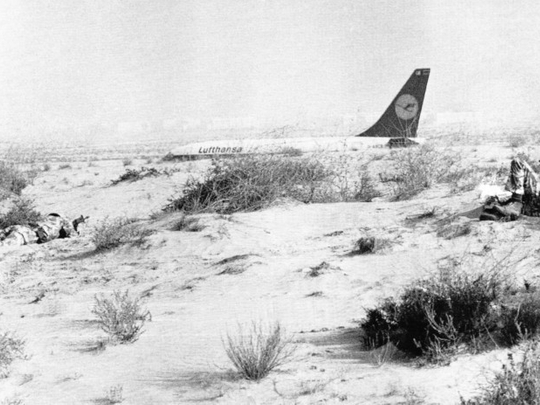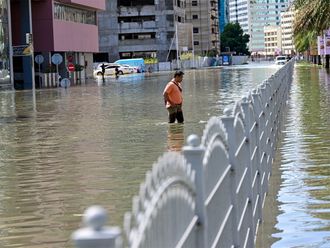
Abu Dhabi: A professor at Khalifa University has compiled a series of English newspaper clippings from the 1970s into a book that gives a glimpse into some of the safety and security challenges the UAE faced during that decade.
The book, ‘Catastrophes, Crashes & Accidents in the UAE: Newspaper articles of the 1970s’, provides an insight into several events that happened during the decade, including crimes, hijackings, and natural disasters which all together shaped and improved the country’s approach to safety and security.
“[The book] covers examples of civil security incidents during the 1970s … People correctly assess that the security of this place (UAE) is very safe and low risk, however, that [success] has been built on by the excellent work of the Ministry of Interior (MoI) and a whole lot of other agencies,” said Athol Yates, the editor of the publication, during a lecture talk about the book at New York University Abu Dhabi on Wednesday.
Athol Yates talking about the book he edited during a lecture at the New York University Abu Dhabi. Ahmed Kutty/Gulf News
“This book highlights that there has been a very large number of threats and hazards that the UAE has faced. [The publication] covers these hazards, [such as] earthquakes, technological disasters, accidents, man-made hazards, and biological hazards,” he added.
Yates added that the book received approval from the National Media Council (NMC), and also received support from the MoI.
Explaining the process of gathering all the information, Yates said he gathered a team of volunteers to go through the national archives to find all the relevant material that was needed.
“We extracted the [information] from these newspapers — The Abu Dhabi News, UAE News, [and] Emirates News, they were all government newspapers that initially started out as one large piece of paper folded in two. [The fourth newspaper was] the Gulf Weekly Mirror, a private newspaper that first started out in Bahrain and then in the 1970s it moved down to Dubai.
“I put out a call for volunteers who were willing to go through this giant pile of newspapers from the 1970s, so we had teams of people, and we told them the stories we wanted, and they went out and found them from the National Archive,” he added.
One of the fascinating insights given by the book was about several plane hijackings that took place during that era.
“Up to 1977, there were five hijackings by various groups — the Red Brigade, which was a leftist group from Germany that was trying to push for the end of imperialism. There was also a Japanese Red Brigade that carried out a hijacking and they were linked to some other groups in Lebanon. So there was a whole range of nationalities and causes that resulted in the hijackings,” he said.
“One of the more famous incidents was when His Highness Shaikh Mohammad Bin Rashid Al Maktoum, Vice-President and Prime Minister of the UAE and Ruler of Dubai, played an instrumental role in forming the military response [against the hijacking], at the time he served as the defence minister,” explained Yates, talking about the Lufthansa Flight 181 hijacking on October 13, 1977. The plane was hijacked during a flight from Spain by four members of the Popular Front for the Liberation of Palestine. and later diverted to several destinations, including Dubai.
Shaikh Mohammad Bin Rashid, who was then defence minister, strategising the response to the hijacking in 1977. framepool.com
“What was fascinating was the amount of direct involvement in the incident [from the newspapers], in terms of the reporting there was a lot of detail about the operational response … In an interview, Shaikh Mohammad said that it was his plan to keep the hijackers nervous in the event that they would give up, and in more quotes [he said] they kept up a constant movement of cars and helicopters to make [the hijackers] nervous, and also delayed the plane’s refuelling for 18 hours,” he added.
Yates went on to describe how a German counter-terrorism group arrived in Dubai to storm the hijacked plane, but those plans were delayed after the plane left Dubai and eventually landed in Mogadishu, Somalia, for the operation to be successfully carried out there.
As the UAE was still a new country during the 1970s, the newspapers were a great source for documenting the nation’s early security developments during that era, which usually came from lessons learnt by accidents.
“There were a series of interesting crashes and when you start to look at the same similar type of incident at the same location, what you do see occurring afterwards is the UAE leadership making a major change to address the problem,” Yates said.
Cars go off Maktoum Bridge
“A man and his wife were driving on the [Maktoum] Bridge, [the car] had a blow out, and the vehicle went off the Maktoum Bridge and into the water. the man who was driving died, and the wife able to swim out. A short time after that, a second vehicle was involved in the exact same incident, and then after the second incident [a newspaper report] mentioned how death crash barriers were installed [on the bridge].
“So you saw like a month later that the authorities had rectified the problem and it was therefore impossible for other cars to go off the bridge, and so you see quite a lot of reactive responses to incidents,” he added.
Fire safety code
Another incident that would have a big impact on the country’s fire safety code was a major fire that broke out at an Abu Dhabi hotel that left several dead.
“This fire was a seminal point in the history of the Abu Dhabi Civil Defence and the building [safety] code. When the hotel was built, there wasn’t a building code, there was no fire safety code. This building was typical of that period, it had no fire alarms, no sprinkler systems, had no secondary escape, and it had no fire hydrants on any of the floors. Worst of all, it had a whole lot of flammable material on the walls and ceilings,” Yates said. “The hotel caught fire because there was so much plastic everywhere, a couple of people who were stuck on the top floor had to jump out of the building, and they died as a result. Other people inside the building were burnt, and so there were quite a lot of deaths.
“As a direct result [of the fire], within about one month later the Abu Dhabi Government had started drafting fire regulations that would address all of the faults, requiring fire alarms, secondary escapes, no flammable materials [inside the building], and the requirement to have fire extinguishers,” he added.












